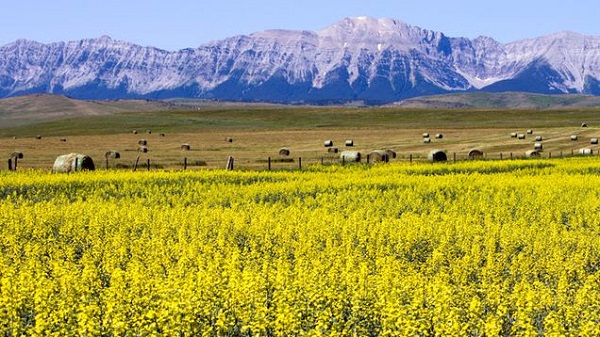Alberta
Alberta: The fuel for global growth in 2025

By Patrick Malkin
In an era defined by economic volatility and political strife, Alberta stands out as a beacon of success, outpacing many areas of North America in growth and innovation. The province’s achievements can be attributed to a combination of prudent governance, resource management, and a commitment to diversification that positions it as a model for other regions.
At the heart of Alberta’s success is its robust economy, driven primarily by its abundant natural resources. The province is rich in oil, gas, and minerals, which have historically fueled its growth. However, what sets Alberta apart is its ability to adapt and evolve. Unlike many resource-dependent regions, Alberta has not rested on its laurels. Instead, it has invested in technology and innovation to enhance its energy sector’s efficiency and sustainability. Initiatives aimed at carbon emissions and promoting innovative energy are gaining traction, demonstrating that Alberta is not merely a fossil fuel powerhouse but a forward-thinking leader, and breadbasket for energy in North America.
Alberta is addressing growing global energy needs by leveraging AI adoption, fueling a robust expansion our energy sector and taking the lead in a new era of energy innovation which could produce worldwide benefits.
The Danielle Smith government has embraced fiscal responsibility and business-friendly policies that attract investment. By maintaining competitive tax rates and fostering a regulatory environment that encourages entrepreneurship, the province has become a magnet for both domestic and international businesses. This strategic approach leads to job creation and economic resilience, even in the face of global downturns. While other regions grapple with increased unemployment and stagnant growth, Alberta’s job market shows strength, reflecting the effectiveness of its policies.
Education and workforce development also play pivotal roles in Alberta’s success story. The province has invested heavily in education and skills training, ensuring that its workforce is equipped to meet the demands of a rapidly changing economy. With a focus on STEM (science, technology, engineering, and mathematics) fields, Alberta is cultivating a generation of innovators and problem solvers who will drive the next wave of economic growth. This commitment to human capital development is a crucial differentiator, setting Alberta apart from regions that have neglected investment in education.
Alberta’s diverse economy is another factor contributing to its success. While the energy sector remains vital, the province has successfully expanded into agriculture, technology, tourism, and manufacturing. This diversification mitigates the risks associated with reliance on a single industry and enhances overall economic stability. As the global economy shifts, Alberta’s varied economic landscape positions it to adapt more readily to change than regions heavily reliant on an individual sector.
Political stability and effective governance cannot be overlooked. Alberta’s leadership under Smith, has prioritized transparency and accountability, fostering public trust and engagement. By listening to the needs of its constituents and responding with effective policy solutions, the government has cultivated a sense of unity and purpose that resonates with Albertans. This contrasts sharply with the polarization seen in other parts of North America, where political gridlock can stifle progress.
Alberta’s success is not merely a product of its natural resources; it is the result of strategic planning, investment in human capital, and a commitment to innovation and diversification. As other regions struggle with economic challenges and levels of economic instability, Alberta serves as a shining example of what can be achieved through sound governance and forward-thinking policies. As we move further into the 21st century, the lessons learned from Alberta’s remarkable rise may hold the key to unlocking potential in other regions, reminding us that success is not merely about resources but about how we choose to leverage them for the greater good.

Patrick Malkin
Deputy Chief of Staff for Operations
Province of Alberta
@MalkinPcos on X
Alberta
Alberta Next Panel calls to reform how Canada works

From the Fraser Institute
By Tegan Hill
The Alberta Next Panel, tasked with advising the Smith government on how the province can better protect its interests and defend its economy, has officially released its report. Two of its key recommendations—to hold a referendum on Alberta leaving the Canada Pension Plan, and to create a commission to review programs like equalization—could lead to meaningful changes to Canada’s system of fiscal federalism (i.e. the financial relationship between Ottawa and the provinces).
The panel stemmed from a growing sense of unfairness in Alberta. From 2007 to 2022, Albertans’ net contribution to federal finances (total federal taxes paid by Albertans minus federal money spent or transferred to Albertans) was $244.6 billion—more than five times the net contribution from British Columbians or Ontarians (the only other two net contributors). This money from Albertans helps keep taxes lower and fund government services in other provinces. Yet Ottawa continues to impose federal regulations, which disproportionately and negatively impact Alberta’s energy industry.
Albertans were growing tired of this unbalanced relationship. According to a poll by the Angus Reid Institute, nearly half of Albertans believe they get a “raw deal”—that is, they give more than they get—being part of Canada. The Alberta Next Panel survey found that 59 per cent of Albertans believe the federal transfer and equalization system is unfair to Alberta. And a ThinkHQ survey found that more than seven in 10 Albertans feel that federal policies over the past several years hurt their quality of life.
As part of an effort to increase provincial autonomy, amid these frustrations, the panel recommends the Alberta government hold a referendum on leaving the Canada Pension Plan (CPP) and establishing its own provincial pension plan.
Albertans typically have higher average incomes and a younger population than the rest of the country, which means they could pay a lower contribution rate under a provincial pension plan while receiving the same level of benefits as the CPP. (These demographic and economic factors are also why Albertans currently make such a large net contribution to the CPP).
The savings from paying a lower contribution rate could result in materially higher income during retirement for Albertans if they’re invested in a private account. One report found that if a typical Albertan invested the savings from paying a lower contribution rate to a provincial pension plan, they could benefit from $189,773 (pre-tax) in additional retirement income.
Clearly, Albertans could see a financial benefit from leaving the CPP, but there are many factors to consider. The government plans to present a detailed report including how the funds would be managed, contribution rates, and implementation plan prior to a referendum.
Then there’s equalization—a program fraught with flaws. The goal of equalization is to ensure provinces can provide reasonably comparable public services at reasonably comparable tax rates. Ottawa collects taxes from Canadians across the country and then redistributes that money to “have not” provinces. In 2026/27, equalization payments is expected to total $27.2 billion with all provinces except Alberta, British Columbia and Saskatchewan receiving payments.
Reasonable people can disagree on whether or not they support the principle of the program, but again, it has major flaws that just don’t make sense. Consider the fixed growth rate rule, which mandates that total equalization payments grow each year even when the income differences between recipient and non-recipient provinces narrows. That means Albertans continue paying for a growing program, even when such growth isn’t required to meet the program’s stated objective. The panel recommends that Alberta take a leading role in working with other provinces and the federal government to reform equalization and set up a new Canada Fiscal Commission to review fiscal federalism more broadly.
The Alberta Next Panel is calling for changes to fiscal federalism. Reforms to equalization are clearly needed—and it’s worth exploring the potential of an Alberta pension plan. Indeed, both of these changes could deliver benefits.
Alberta
Alberta’s huge oil sands reserves dwarf U.S. shale

From the Canadian Energy Centre
By Will Gibson
Oil sands could maintain current production rates for more than 140 years
Investor interest in Canadian oil producers, primarily in the Alberta oil sands, has picked up, and not only because of expanded export capacity from the Trans Mountain pipeline.
Enverus Intelligence Research says the real draw — and a major factor behind oil sands equities outperforming U.S. peers by about 40 per cent since January 2024 — is the resource Trans Mountain helps unlock.
Alberta’s oil sands contain 167 billion barrels of reserves, nearly four times the volume in the United States.
Today’s oil sands operators hold more than twice the available high-quality resources compared to U.S. shale producers, Enverus reports.
“It’s a huge number — 167 billion barrels — when Alberta only produces about three million barrels a day right now,” said Mike Verney, executive vice-president at McDaniel & Associates, which earlier this year updated the province’s oil and gas reserves on behalf of the Alberta Energy Regulator.
Already fourth in the world, the assessment found Alberta’s oil reserves increased by seven billion barrels.
Verney said the rise in reserves despite record production is in part a result of improved processes and technology.
“Oil sands companies can produce for decades at the same economic threshold as they do today. That’s a great place to be,” said Michael Berger, a senior analyst with Enverus.
BMO Capital Markets estimates that Alberta’s oil sands reserves could maintain current production rates for more than 140 years.
The long-term picture looks different south of the border.
The U.S. Energy Information Administration projects that American production will peak before 2030 and enter a long period of decline.
Having a lasting stable source of supply is important as world oil demand is expected to remain strong for decades to come.
This is particularly true in Asia, the target market for oil exports off Canada’s West Coast.
The International Energy Agency (IEA) projects oil demand in the Asia-Pacific region will go from 35 million barrels per day in 2024 to 41 million barrels per day in 2050.
The growing appeal of Alberta oil in Asian markets shows up not only in expanded Trans Mountain shipments, but also in Canadian crude being “re-exported” from U.S. Gulf Coast terminals.
According to RBN Energy, Asian buyers – primarily in China – are now the main non-U.S. buyers from Trans Mountain, while India dominates purchases of re-exports from the U.S. Gulf Coast. .
BMO said the oil sands offers advantages both in steady supply and lower overall environmental impacts.
“Not only is the resulting stability ideally suited to backfill anticipated declines in world oil supply, but the long-term physical footprint may also be meaningfully lower given large-scale concentrated emissions, high water recycling rates and low well declines,” BMO analysts said.
-

 Alberta1 day ago
Alberta1 day agoAlberta’s huge oil sands reserves dwarf U.S. shale
-

 Alberta1 day ago
Alberta1 day agoCanada’s New Green Deal
-

 Energy1 day ago
Energy1 day agoCanada’s sudden rediscovery of energy ambition has been greeted with a familiar charge: hypocrisy
-

 Business1 day ago
Business1 day agoCOP30 finally admits what resource workers already knew: prosperity and lower emissions must go hand in hand
-

 armed forces1 day ago
armed forces1 day agoOttawa’s Newly Released Defence Plan Crosses a Dangerous Line
-

 Business1 day ago
Business1 day agoOttawa Pretends To Pivot But Keeps Spending Like Trudeau
-

 Indigenous1 day ago
Indigenous1 day agoResidential school burials controversy continues to fuel wave of church arsons, new data suggests
-

 Daily Caller1 day ago
Daily Caller1 day agoParis Climate Deal Now Decade-Old Disaster







